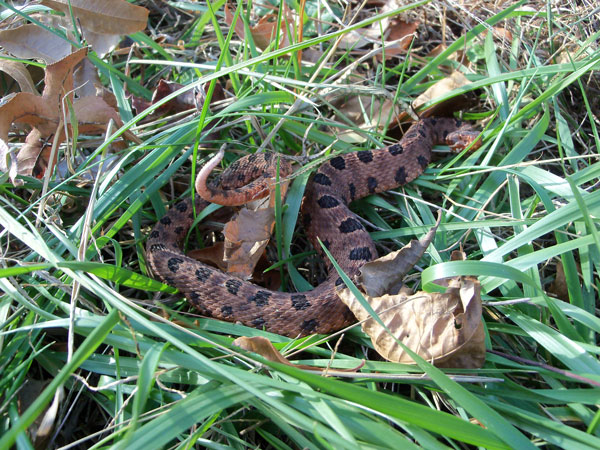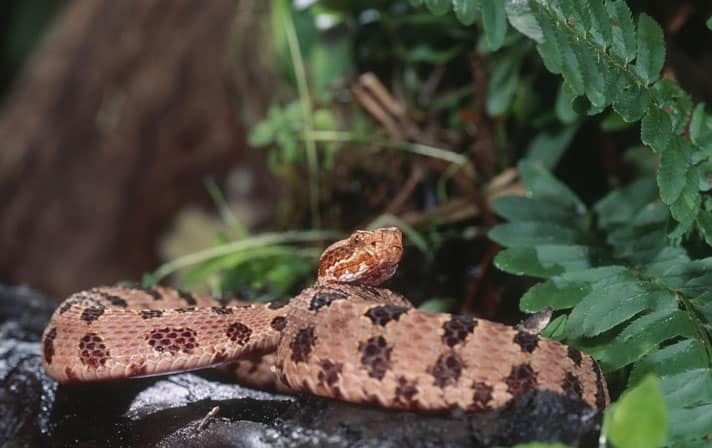Pigmy Rattlesnake (Sistrurus miliarius) There are three subspecies of pigmy rattlesnake – the Carolina pigmy (S. m. miliarius), the dusky pigmy (S.
Pigmy Rattlesnake (Sistrurus miliarius)
There are three subspecies of pigmy rattlesnake – the Carolina pigmy (S. m. miliarius), the dusky pigmy (S. m. barbouri), and the western pigmy (S. m. streckeri). All three subspecies can be successfully maintained according to this care sheet.
Small, often pugnacious, and always alert, pigmy rattlesnakes make interesting captives. Also known as ground rattlers and sand rattlers, these small pit vipers can be found throughout the Southeast and southern Midwest United States basking on sunny days and crossing roads in the morning or early evening. Being rattlesnakes, pigmies do have rattles, although they are very small and often broken on wild animals. The tiny rattle is very quiet, often sounding more like a buzzing insect than a rattlesnake. They are highly variable and range in color anywhere from pale grey to almost black, brown, red, pink, orange, blue or lavender. Whatever the background color, there are always a series of black or brown blotches on their backs, typically overlaying an orange dorsal stripe. The belly is usually mottled with white and the same general color as the snake.

Kristopher Boldizar
Carolina pigmy rattlesnake.
Pigmy Rattlesnake Availability
Pigmies are available from many classified websites and reptile shows. Shows are the best place to acquire a new pigmy rattlesnake since the cost of legally shipping a venomous reptile is quite high. Wild caught specimens are typically the most abundant and take quite well to captivity with species specific snake supplies and husbandry. However, as with any wild caught reptile, there are many potential health problems. Also, some subspecies are protected by law in parts of their range. Dusky and Carolina pigmies are being captive bred in good numbers and usually readily available. Newborn pigmies can be very difficult to get started, so unless you have the experience, patience, and resources required, it is best to look for well established babies. Whatever you decide, choose a snake that looks alert, free of any visible defects, and outwardly healthy.
Pigmy Rattlesnake Size
Averages right around two feet, although some dusky pigmies have been recorded over 30 inches.
Pigmy Rattlesnake Life Span
Pigmy rattlesnakes can live more than 20 years, and reach sexual maturity at around 3 years of age.
Pigmy Rattlesnake Caging
A 40 gallon long reptile terrarium will house a single adult pigmy comfortably. Pairs or trios do well housed together, preferably in a 30 or 40 gallon ‘breeder’ tank, but remember to separate them at feeding time to avoid any accidents. These are VENOMOUS snakes…secure, lockable, escape-proof caging is the only option!
Stats
Scientific name: Sistrurus miliarius ssp.
Family: Viperidae
Adult Size: roughly 16-24 inches
Wild Range: Northeastern NC, south to FL, west to eastern OK and TX to southeastern MO
Wild Habitat: Typically found in field-edges associated with mature mixed pine and hardwood forests, also found with palmetto and hardwood hammocks in the southern part of their range.
Pigmy Rattlesnake Lighting and Temperature
Pigmies like to bask and should be provided with an area to do so in the upper 80’s to low 90’s. Ambient daytime temperatures should be in the low 80’s with about a 10 degree drop at night. Ensure cage space is sufficient to allow the snake to thermoregulate properly.
Pigmy Rattlesnake Substrate
I use cypress mulch, but any commercially available reptile substrate will do, as will newspaper. Due to their size and habits, pigmy rattlesnakes are ideal for naturalistic displays that go well with snake habitat products and accessories.
Pigmy Rattlesnake Food
Neonates can require a very wide range of food items including, but not limited to mouse pinks, skinks, anoles, small fish, earthworms, insects, and other small snakes. Juveniles and adults should eat appropriately-sized rodents.
Pigmy Rattlesnake Water
Fresh, clean water should be available at all times. Most pigmies will quickly hide from being misted but after the spray has stopped, they can be seen exploring their enclosure slurping up water droplets, so portable mister pressure sprayer could be useful.
Pigmy Rattlesnake Safety Precautions
As with any venomous snake, these are NOT for beginners! Caging must be secure, preferably lockable, and avoid screen or mesh on any of the vertical sides. Pigmy rattlers generally do not sit well on a hook and a shift box is a better method of transfer. DO NOT attempt to handle or ‘tail’ pigmy rattlesnakes, their small size means your hand will be too close to the fangs, even on a large adult. Contact your local hospital and find out if they are prepared to handle a venomous snakebite, and keep a copy of a proper bite protocol, complete with species information, handy to take with you if you get bitten. Remember, you may be unable to tell the hospital staff what happened or what to do!
Pigmy Rattlesnake Reproduction and Breeding
Pigmy rattlesnakes typically breed in the fall, hibernate over the winter, and birth their litters in late summer. Male to male combat is not necessary to stimulate breeding, but may help if you’re having difficulty. Try introducing the pair to each other in August and leave them together through hibernation, which I begin by slowly cooling and reducing photoperiods in mid October.
It is very important to ensure that the last meal eaten has been completely digested and passed and the snakes are at a healthy weight before attempting hibernation. By the beginning of November, the snakes are in full darkness and cold temps (45-55 deg, not as crucial for duskys). It is important to disturb them as little as possible during this process, only checking the water periodically in the dimmest light that is safe to work with. The snakes are awake and aware throughout hibernation, and, although slow, they are capable of delivering a bite.
Around mid February, start gradually increasing ambient temperatures and photoperiods over a two week span until things are back to pre-hibernation levels. I usually wait until they appear active and begin cruising the enclosure before feeding the first post-hibernation meal, which should be a little smaller than usual. Using a thermometer will help regulate and observe the temperatures in your habitat. Gravid females may eat up to the day they birth their litter or not at all until they birth their litter. Some females will appear gravid when you bring them up, others may take a while to show.
As soon as you’re fairly certain a female is gravid, it is a good idea to house her alone. I typically move my gravid females to a thermostat-controlled (86 degrees) shoebox rack with clean aspen or newspaper bedding. There is usually a pre-birth shed about a week before the event. When the time is right, she will drop anywhere between 3 and 15 babies but less or more are possible. Surprisingly, most pigmy rattlesnakes are born already opaque or even already in the process of shedding. It is common practice to leave the babies with her for a few days, and this may make the difference between the neonates being eager feeders or not. If you’ve reached this point, congratulations! Now the real work begins…GOOD LUCK


